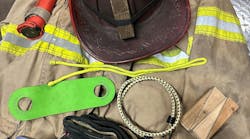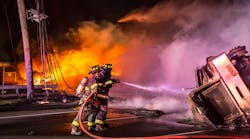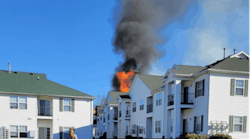No matter where I am, I see a fire engine drive by or I get a look at the hosebed on one. Hosebeds are quite unique and sometimes they are downright strange looking.
The interesting and important aspect of any hosebed is how well it serves as a tool to fight fires. One of the most important features of a well-designed and effective hosebed is the number, size and lengths of the attack hoselines it holds. (Yes, supply lines are important, but this discussion will focus on attack hoselines.)
Ready for work
For an engine company apparatus to be ready to go to battle, it must have several types of attack hoselines. I like to call them the small and the large attack lines.
The small attack hoseline is most commonly 1¾-inch hose. Some departments do still use 1½-inch hose, but not many. Either way, both 1½-inch and 1¾-inch attack hoselines are used for the same work.
Now, here is where the variables appear. I have not seen many engines with only one small attack hoseline. Almost every engine I have seen has two separate compartments or crosslays with a 1¾-inch hoseline ready to be stretched. Obviously, if you have one line, you may need a second as a backup line. The real question here is whether they are same length.
I have heard dozens of firefighters explain that both of their two 1¾-inch hoselines are 200 feet long. I always ask, “Why?” I get lots of different answers and very few make much sense.
I usually explain that the benefits of having two attack hoselines with one longer than the other are many. First, you can use the shorter line, if it is long enough, to stretch into a home or commercial building to fight a fire and you are left with the second, longer line that can be used to reach the second floor or other area above the fire area.
Second, if both of your lines are the same, you have to stretch whatever length it is, no matter how close the fire is to the apparatus. For example, if you pull up in front of a home that is just 25 feet back from the sidewalk and the fire is in the front room on the first floor, you may still have to stretch the five-length 1¾-inch hoseline because both of the attack lines are five lengths. If you have three lengths of hose on the short line and five on the long line, you can stretch the short line to the fire and have the long line for the floor above in necessary. So consider having different lengths of hose available if you have several 1¾-inch attack hoselines.
What other kind of hoseline does a good engine need? Every engine apparatus needs a 2½-inch attack hoseline ready to go. Ready to go means 2½-inch hose, with a nozzle attached, packed and ready to be stretched when needed, NOT a bed of 2½-inch hose without a nozzle that can be used after a nozzle is attached from a compartment. A 2½-inch hose is not used very often, but that should have no bearing on your decision to have one ready. When you encounter a large fire where exposures must be protected or a fully involved structure where outside lines are needed immediately for a defensive operation, there is no time to start assembling the big line to do the job.
Last, what DON’T you need? Many new engines are being delivered today without a booster reel. I’m not saying there are no uses for it, but a 1¾-inch hoseline will do everything a booster line could do and much more. In fact, some departments eliminated booster reels after that hose was stretched into a “really minor” fire inside a garage and the building burned down. If it’s not available, it is hard to misuse it.
Engine operations are the backbone of the American fire service. What we do, how we do it and with what tools, equipment and hose we use are all important to our mission. Next time you are on the apparatus floor, take a good look at your engine’s hosebed. Check out the lengths of the attack hoselines. Look at the different diameters of hose available and whether you have small and large and short and long lines to do your job at the next fire.
Chief Salka takes a candid look at news and events impacting the fire service in his blog “The Fire Scene” at http://www.firehouse.com/blogs/the-fire-scene.
John J. Salka Jr. presents “Chief Officers Combat School” and “Rapid Intervention School” at Firehouse World 2015.





